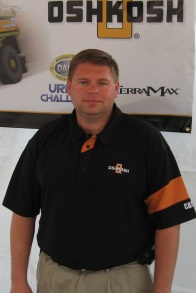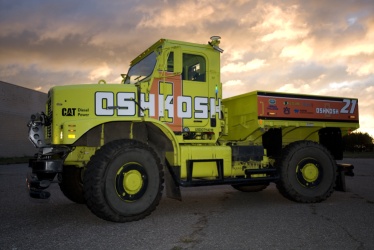 In what seems to be a recurring theme among DARPA Urban Challengers, these guys have greater ambitions than winning the race. “The goal was to be a strong performer, not necessarily win,” Chris Yakes, Director of the Advanced Products Group for Oshkosh, said.
In what seems to be a recurring theme among DARPA Urban Challengers, these guys have greater ambitions than winning the race. “The goal was to be a strong performer, not necessarily win,” Chris Yakes, Director of the Advanced Products Group for Oshkosh, said.
Yakes explained that his team is developing an autonomous system in kit form similar to other kits the company provides to its military customers. Approximately 30% of Oshkosh’s business is in the military sector. The price of the kit will be comparable to the cost of their armored vehicle kit.
The kit still needs a little bit of fine-tuning. “We’re a couple of years from having a final product but we’re ready now to start doing demonstrations. By demonstrations I mean offering a vehicle (retrofitted with the kit) to a customer and letting them see first hand how it performs.” Yates went on to explain that variations of the autonomous system might be ready sooner. A semi-autonomous follower / leader system, for example, might be applied in a convoy of several vehicles in which only one contains a human driver or it is teleoperated.
Oshkosh has made some very overt technical design decisions based on the deep knowledge it has of its customer base. Their systems must be able to perform in very harsh environments and remain highly dependable for decades. “Our trucks live about 20 years. The system we provide must last at least that long.” Yates explained that they bias their technology selection to those without moving parts. Their computers are commercial off-the-shelf (“COTS”) systems that are cheap, easily replaced, and very durable. Oshkosh also depends more on computer vision than any other team that performed in the competition because cameras can be very rugged as they have no moving parts.
Computer vision is the method of identifying characteristics of a scene from digital images. Algorithms vary substantially depending on the desired data. Streoscopic vision, for example, requires two side-by-side cameras each generating an image of the same scene each from a slightly different perspective. The software behind this configuration finds objects of one image in the other. If the software finds the object in the same position on both images, the element is deemed to be far away. If the software finds that the object’s position has “shifted,” the object can be characterized as being closer to the cameras. The greater the shift, the closer the object is. From such information a 3D representation of the scene is constructed. Oshkosh is working with the University of Parma in Italy to develop the software behind their computer vision system.
Biasing towards cameras does not necessarily make them the only sensor in the kit. Oshkosh has also chosen to use ibeo LIDAR scanning technology to supplement their computer vision system. Yates was very reserved when asked details about other systems they evaluated and why they chose ibeo; however, he did explain the role of the ibeo. There are three units on the vehicle–two forward units and one rear. The units are used to identify obstacles.
During a conversation with 3rd-Place winner Virginia Tech Team Leader Charles Reinholtz about their own implementation of the ibeo sensors, Robot Central learned that there were occasions that the ibeo would be blinded and the system would require a reboot. There was at least one time when their robot, Odin, paused itself for approximately 90 seconds while it rebooted its ibeo systems. Team Oshkosh was eliminated when their robot threatened to bring down a building after it ran off the course and met a load-bearing pillar. As of the writing of this article, it was unclear if any contact was made nor was it clear if the failure was due to the ibeo issue described by Virginia Tech.
Nevertheless, Oshkosh is optimistic about its future role in saving the lives of American soldiers. And it should be. The sensor vendors will address their issues and Oshkosh will continue to mature its product. Oshkosh’s performance in the 2005 Grand Challenge and in this year’s 2007 Urban Challenge has very effectively demonstrated its technical and business prowess.




I’m enjoying this blog!